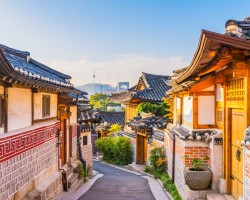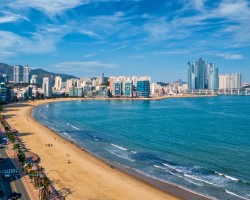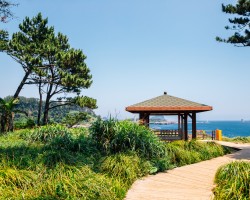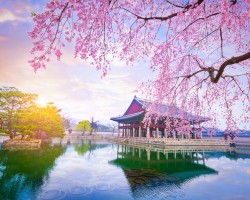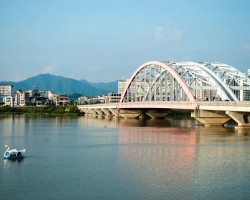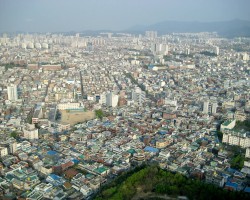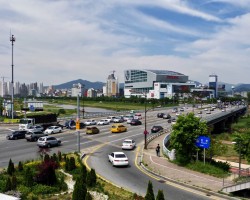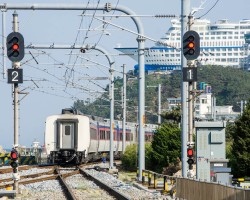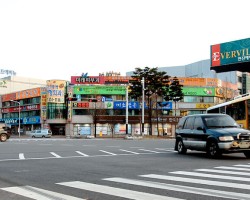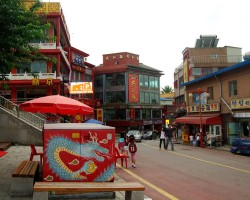Best time to go to South Korea for a perfect weather and where to go?
When is the best time to go to South Korea?
The best time to visit South Korea with pleasant weather is from May to June (late spring) and September to October (early autumn). If you had to choose, opt for autumn: the temperatures are still pleasant and the weather is drier than in spring. However, apart from these two ideal climatic periods, others should be considered:
- If you want to admire the spectacle of cherry blossoms in South Korea, plan your trip in March.
- From mid-October to mid-November, it is the autumn foliage season in Korea. The country is adorned with spectacular autumn colors.
- Summer, or monsoon season between June and August, offers a unique atmosphere combining humidity, heat, and lush vegetation.
- Winter, from December to February, is very cold, but offers the opportunity to witness beautiful snowy landscapes and ski slopes.
It is also important to know that the high season in South Korea runs from April to December, with peak attendance in July-August and December, during European school holidays. The months of January to March are considered the low season. If you are not afraid of the cold, it is the ideal time to enjoy tourist sites without a significant influx of visitors.
Finally, the choice of your travel dates can also be influenced by your budget. Indeed, August is the most expensive month of the year, whether for plane tickets or accommodations once there. On this point, it is also preferable to travel during the shoulder seasons.
Where and when to go based on the weather?
Central of South Korea
Cheongju, Koesan...
East of South Korea
Daegu, Pohang, Andong...
North West of South Korea
Seoul, Incheon, Anseong...
Northeast of South Korea
Sokcho, Gangneung, Chuncheon...
South of South Korea
Busan, Jeju Island (Jejudo), Gwangju...
West of South Korea
Daejeon, Jeonju, Seosan...
To get all the information about the climate and weather in South Korea for a specific month, click on the corresponding link below:
South Korea in january South Korea in february South Korea in march South Korea in april South Korea in may South Korea in june South Korea in july South Korea in august South Korea in september South Korea in october South Korea in november South Korea in december
Best time to travel to South Korea by cities
Climate and Weather in South Korea
Relatively rare in Asia, the weather in South Korea is characterized by four distinct seasons: autumn, winter, spring, summer. Moreover, the country reveals a wide variety of climates. At the same time and depending on the region, once can experience scorching temperatures or, on the contrary, cool to cold temperatures. Here are the climates found in South Korea:
- A humid subtropical climate with hot summers and the other seasons dry and temperate. This is the predominant climate type in the country.
- A humid continental climate with hot summers and very dry winters, as in Seoul.
- A humid subtropical climate with dry and temperate winters, as well as hot summers, as in Incheon.
- A humid continental climate with hot summers and no dry season, as in Daejeon.

The different seasons in South Korea
- Let's start with winter, which lasts from December to February. South Korea's climate is characterized by a harsh winter, especially in the northeast and center of the country, where snow can be present until early March. Temperatures can easily drop below -10°C, especially when polar winds from Siberia blow. In the northwest, the temperature is slightly milder, and in the south, winter is much less severe than elsewhere. In any case, don't forget to bring warm clothes, especially if you want to fully enjoy the ski resorts or stroll through the beautiful snowy landscapes.
- Then comes spring, from March to May, a season highly appreciated in South Korea. The air warms up, nature awakens, and cherry blossoms bloom. It's the perfect time for a peaceful walk in the streets of Seoul or the Buddhist temples. However, expect some precipitation during this period, especially in the north and center of the country.
- Summer, from June to August, is hot and humid in South Korea. The temperature can easily rise to over 30°C, but it's the humidity that can be the most uncomfortable. Expect frequent and sometimes heavy rains because it's the famous monsoon season, during which a tropical wind blows from the sea to the land, bringing along rain-laden clouds. Once or twice a year, these precipitations turn into typhoons, so you need to be extra cautious if you are on the coast during this period. That being said, summer is still the perfect time to relax on the beautiful beaches of the country, even if the sky is overcast.
- Finally, autumn, from September to November, is arguably the most charming season to visit South Korea. The air is cool and dry, with rare precipitation. The tree leaves adorn themselves with a thousand shades of yellow, orange, and red, creating a natural masterpiece. It's an ideal time for hiking in the country's numerous national parks.
Climate specifics by region
Climate in southern South Korea
In the south, South Korea experiences a humid subtropical climate with two variations: no dry season and hot summer, as in Busan, or dry winter and hot summer, as in Tongyeong. The most favorable months to visit are April, May, June, September, and October, but it's still possible to consider a trip in July and August to enjoy beach activities.
Slightly more affected by trade winds, the South Korean coast still benefits from a very pleasant climate. Although much less vulnerable than its neighbors, China, the Philippines, or Taiwan, to typhoons, this meteorological phenomenon remains a possibility. Typhoons usually occur at the end of summer, causing some floods with considerable damage.
Climate in northern and central South Korea
In winter, while most of South Korea experiences snowfall, it's in the north, especially in ski resorts like Muju, where the lowest temperatures are found.
In Seoul, the capital, the weather is also very cold during this time of the year, with averages between -5°C and 5°C. In summer, the heat is bearable, although humidity is still present, especially in July. The best time to visit is in May, June, September, or October.
In the northeast and central South Korea, the climate is decidedly continental, with many variations depending on altitude and latitude. Most of the time, humidity and heat prevail in summer, but winters are harsh and very dry. The best periods for the most favorable weather conditions are May, June, and September.
Climate in eastern and western South Korea
In winter, from December to March, these two Korean regions experience similar weather with a predominant humid subtropical climate without a dry season. Thus, it may rain from time to time, but the thermometer can show pleasant averages around 15°C in the middle of the day. However, nights remain cold.
In summer, from June to September, the east is preferred. Indeed, this region is much less affected by monsoon rains, and the months from May to October are all favorable for an exceptional trip. In the west, July and August are rainy, so it's better to choose the periods before and after.
Temperatures and rainfall in South Korea
On these 3 graphs, we present the evolution of temperatures of South Korea and month-by-month rainfall for the cities of Seoul, Busan, Jeju Island (Jejudo), Andong and Anseong, as well as the month-by-month sea temperature for coastal cities.
Peak visitor numbers and tourist seasons in South Korea
Find out when South Korea has its high tourist season (the period when the influx of tourists is highest) and off-peak tourist season using our data and figures.
Tourist seasons in South Korea
The months with low numbers of tourists are: January, February, March, June and November. The number of visitors to South Korea is high in: April, May, July, August, September, October and December.
- Very low season in South Korea: February.
- Low season in South Korea: January, March, June and November.
- High season in South Korea: April, May, July, August, September and December.
- Peak season in South Korea: October.
Figure: Visitor index for South Korea month by month
Average price for flights to South Korea
A return flight between Sydney and Seoul is generally cheaper if you go in may ($ 683 on average): this is the best time for travellers on a tight budget. In contrast, you may end up paying $ 306 more for your airline ticket to Seoul if you go in december.
Find the best price for your flight Flight prices to South Korea
Where to go in South Korea?
This table allows you to see the maximum temperature for each city and our opinion on the weather month by month (see colour legend below the table).
| Cities | jan. | feb. | mar. | apr. | may | jun. | jul. | aug. | sep. | oct. | nov. | dec. |
| Seoul | 1°C | 5°C | 11°C | 17°C | 23°C | 28°C | 30°C | 31°C | 27°C | 21°C | 12°C | 3°C |
| Busan | 7°C | 9°C | 13°C | 16°C | 21°C | 24°C | 27°C | 29°C | 25°C | 21°C | 16°C | 9°C |
| Jeju Island (Jejudo) | 8°C | 9°C | 12°C | 16°C | 20°C | 23°C | 27°C | 29°C | 25°C | 21°C | 16°C | 10°C |
| Andong | 1°C | 6°C | 12°C | 17°C | 24°C | 27°C | 29°C | 30°C | 25°C | 19°C | 12°C | 3°C |
| Anseong | 2°C | 5°C | 11°C | 17°C | 23°C | 27°C | 29°C | 30°C | 26°C | 20°C | 13°C | 4°C |
| Cheongju | 2°C | 6°C | 12°C | 18°C | 24°C | 28°C | 30°C | 30°C | 26°C | 20°C | 13°C | 4°C |
| Chuncheon | -0°C | 4°C | 10°C | 17°C | 23°C | 27°C | 29°C | 29°C | 25°C | 19°C | 10°C | 1°C |
| Daegu | 4°C | 8°C | 13°C | 18°C | 24°C | 28°C | 30°C | 31°C | 26°C | 21°C | 14°C | 6°C |
| Daejeon | 2°C | 5°C | 12°C | 18°C | 24°C | 28°C | 29°C | 30°C | 26°C | 20°C | 12°C | 4°C |
| Gangneung | 1°C | 4°C | 9°C | 15°C | 20°C | 24°C | 27°C | 27°C | 23°C | 18°C | 11°C | 3°C |
| Gwangju | 5°C | 8°C | 13°C | 18°C | 24°C | 27°C | 30°C | 31°C | 27°C | 21°C | 14°C | 7°C |
| Incheon | 2°C | 5°C | 10°C | 16°C | 21°C | 26°C | 28°C | 30°C | 26°C | 20°C | 13°C | 4°C |
| Jeonju | 4°C | 7°C | 12°C | 18°C | 24°C | 28°C | 30°C | 30°C | 26°C | 21°C | 14°C | 6°C |
| Koesan | 1°C | 5°C | 11°C | 17°C | 22°C | 26°C | 28°C | 29°C | 25°C | 19°C | 12°C | 3°C |
| Pohang | 4°C | 7°C | 11°C | 16°C | 21°C | 24°C | 28°C | 29°C | 25°C | 20°C | 13°C | 6°C |
| Seosan | 3°C | 5°C | 9°C | 14°C | 19°C | 23°C | 26°C | 28°C | 24°C | 19°C | 13°C | 6°C |
| Sokcho | 2°C | 4°C | 9°C | 14°C | 19°C | 22°C | 25°C | 26°C | 23°C | 18°C | 11°C | 4°C |
| Gyeongju | 5°C | 8°C | 12°C | 17°C | 23°C | 26°C | 29°C | 30°C | 25°C | 20°C | 14°C | 7°C |
| Namhae | 7°C | 9°C | 13°C | 17°C | 22°C | 25°C | 27°C | 29°C | 26°C | 21°C | 15°C | 9°C |
| Namiseom (Nami Island) | -0°C | 4°C | 10°C | 17°C | 23°C | 27°C | 29°C | 29°C | 25°C | 19°C | 10°C | 1°C |
Legend:
perfect weather
good weather
tolerable weather
bad weather
very bad weather
About South Korea
What can I do in South Korea?
Beaches / swimming
Nature and countryside
Culture and heritage
Sports
Family travel
Crafts / shopping
Gastronomy
Nightlife
Is this weather information for South Korea reliable?
Climate data for South Korea has been gathered every day since January 2009. The analysis of these meteorological data for South Korea allows us to determine the average for each month in Seoul, Busan, Jeju Island (Jejudo), Andong, Anseong, Cheongju, Chuncheon, Daegu, and 56 other cities.
So yes: this data is reliable except in cases of temporary climate disruption in the region.
